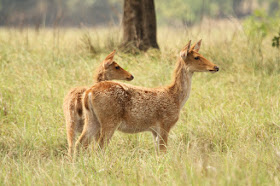I visited Kanha as the first half of a one-week tour to Kanha and Bandhavgarh National Parks, hoping to photograph Bengal tigers in the wild. Dedicated as a national park in 1955, Kanha was one of the first nine parks designated as a tiger reserve under India’s “Project Tiger” which was launched in 1973. Kanha is often described as one of India’s most beautiful parks, and even in the summer heat of early May (about 41 degrees Celsius at mid-day), it was truly a beautiful place. Kanha features dense forests of Sal trees, various deciduous trees, dense bamboo mixed with miscellaneous plants, and wide-open grasslands.
Kanha also features many bodies of water where you often see herds of Sambar deer, Chital deer, and Barasingha deer gathered to get a drink. These animals are ever on the alert for an approaching tiger, and their constant state of tension adds to the atmosphere of excitement.
Visitors
to Kanha usually enter the park in an open-backed jeep (often referred to as a “Gypsy”)
on what is called a “jeep safari”. There
is a morning safari that runs about 4 hours and an afternoon safari of about 3
hours, with starting and ending times that vary according to the time of the
year. In order to minimize negative
effects on the environment, the total number of jeeps allowed into the park
each day is capped. There are four zones
in the park, and according to what I could find on the internet, the current jeep
limit for each of the four zones appears to be: Kanha zone, 28 vehicles in the
morning and 17 vehicles in the evening; Kisli zone, 12 vehicles in the morning,
8 vehicles in the evening; Mukki zone, 28 vehicles in the morning, 17 vehicles
in the evening; and Sarhi zone, 15 vehicles in both morning and evening.
Since
the daily entry to the park is determined by the number of vehicles, not the
number of people, when tourists purchase tickets to enter the park, they are,
in effect, purchasing a ticket for the entire jeep. Thus, a visitor who travels alone will bear
the cost of the entire jeep by himself while a member of a tour group will be
able to split the cost of the jeep with his fellow travelers. Since my travel agent did not itemize the
costs on my tour package, I do not know how much we paid for our jeep, but
information on the internet (information varies on different homepages) indicates
that present prices for entry (entry ticket and jeep fee) into Kanha National
Park appear to be 5,400 rupees for foreigners and 3,600 rupees for Indian
nationals for the Kanha zone; and 4,200 rupees for foreigners and 3,000 rupees
for Indian nationals for the other three zones.
Visitors should also be prepared to pay a separate fee for a
park-assigned guide (300 rupees). (Check
with your travel agent for the latest accurate costs.) Additionally, it is customary to tip both the
driver and guide after each safari. I
was told that the usual rate was 200 rupees to each the driver and guide (more
if you spot a tiger).
The photo below shows the line of jeeps waiting for the afternoon entrance. At this time, travelers sitting in the jeeps are usually excited and full of anticipation. (A few hours later, it is very interesting to look again at people’s faces when they exit the park. You can usually determine whether the passengers of each jeep have spotted a tiger. The lucky ones are the ones who are smiling.)
Once inside the park, each jeep roams around looking for animals - especially the tigers. Sometimes the drivers and visitors are too focused on looking for tigers, and it becomes a little difficult to enjoy spotting the other types of wildlife.
The
vistas in the park are quite beautiful.
Despite
it being the dry season, there were still many bodies of water.
Below
are photos of some of the animals I saw at Kanha.
Gaur
(Bos gaurus)
Chital
deer (Cervus axis)
Indian
Roller (Coracias benghalensis)
Peacock
(Pavo cristatus)
Male
Barasingha deer (Cervus duvauceli branderi)
Female Barasingha
Hanuman Langur
Rhesus
macaque
And
finally, two photos of the only tiger I spotted on my four safari drives into
Kanha. This particular sighting lasted
only about 10 seconds, and I barely had enough time to align my camera lens and
press the shutter button.
By the time I pressed the shutter button a second time, the tiger’s head was no longer in view.
This
tiger sighting occurred only one hour into the first of four safaris in
Kanha. Since this brief sighting occurred
so early into our tour, I was convinced that I would see another tiger at
Kanha. Or, even if I didn’t see one at
Kanha, I would surely see one at Bandhavgarh….or so I thought. In the end, this 10-second glimpse would be
the only tiger I would see during a total of eight safaris on this trip. Unlike in a zoo, there is no guarantee that
an animal will be where you want it to be.
I think that I will be visiting Kanha again - someday.
















